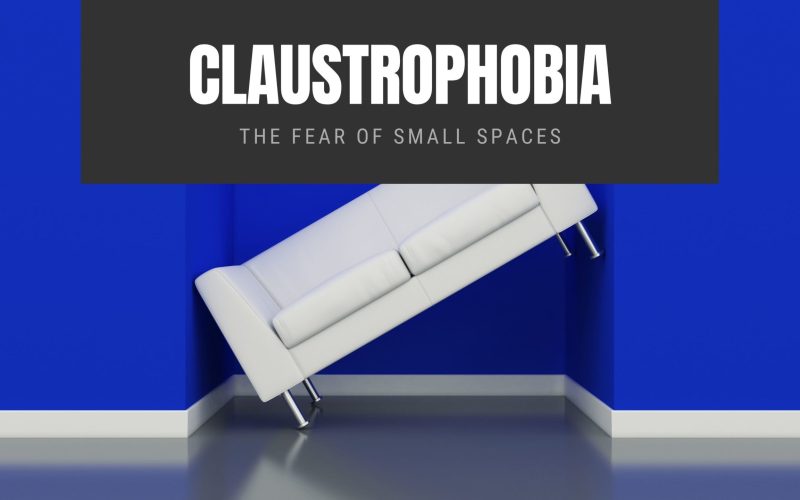Claustrophobia is the fear of enclosed or crowded places where a quick escape seems impossible.
This phobia is a form of anxiety disorder, where an irrational fear of not having an escape route or being closed in can cause a panic attack.
Claustrophobia is categorized as a specific phobia according to information from the Diagnostic and Statistical Manual 5 (DSM-5).
Triggers for claustrophobia symptoms may include being in a small room without any windows, inside an elevator, or even traveling on an airplane.
Though not so common, some people have claimed that putting on a turtle neck or other tight-necked clothing can cause feelings of claustrophobia.
Quick facts about claustrophobia:
Here, we have shared some significant points about claustrophobia.
- Claustrophobia can lead to panic attacks.
- Causes of claustrophobia may include conditioning and genetic factors.
- Claustrophobia affects some people when they find themselves in tight or small spaces.
- A wide range of tips and treatments may help people overcome their fear.
What is Claustrophobia?
The word claustrophobia is derived from the Latin word claustrum, meaning “a closed-in place,” and the Greek word for fear, “Phobos.
Claustrophobic people will go a long way to avoid tight or small spaces or situations that trigger their anxiety and panic.
People with claustrophobia may avoid places such as the subway and would rather take the stairs than an elevator, even if it means spending a long time to get to their destination.
Available data suggests that up to 5 percent of Americans may have claustrophobia.
Symptoms of this phobia may be severe, but the majority of people with claustrophobia do not seek treatment.
Diagnosis
A psychiatrist or psychologist will ask you about your symptoms.
A person may be diagnosed with claustrophobia during a consultation about another mental health or anxiety-related issue.
During a consultation, the psychologist will:
- Ask patients to describe the symptoms they experience and what triggers them
- Try to establish the severity of the reported symptoms
- Rule out other possible anxiety disorders
- To establish some details about the condition, the doctor may use:
- A claustrophobia questionnaire to help with identification of the cause of anxiety
- A claustrophobia scale to help with establishing the levels of anxiety
Claustrophobia is a specific phobia. And before a specific phobia can be diagnosed.
These criteria are:
- A constant unreasonable or excessive fear that is caused by the anticipation or presence of a specific situation
- Anxiety response when a patient is exposed to the stimulus, likely a panic attack in adults or, in kids, a tantrum, crying, clinging, or freezing
- In adult patients, a recognition that their fear is exaggerated and out of proportion to the perceived danger or threat.
- Taking necessary and unnecessary measures to stay away from the feared object or situation, or a likelihood to face the experiences but with anxiety or distress.
- The reaction, anticipation, or avoidance of a patient interferes with his or her everyday life and relationship with work or people or causes significant distress.
- The phobia has gone on for some time, mostly half a year or longer
- Symptoms experienced cannot be attributed to any other mental condition like obsessive-compulsive disorder (OCD) or post-traumatic stress disorder (PTSD).
Symptoms of Claustrophobia
Claustrophobia is seen as an anxiety disorder. Its symptoms usually show up during adolescence or childhood.
Being in a confined space or the thought of it can trigger fears of running out of oxygen, breathing difficulty, and distress at being restricted.
When anxiety levels get to a certain point, the patient may begin to experience:
- Sweating and chills
- Accelerated heart rate and hypertension (high blood pressure)
- Dizziness, fainting, and lightheadedness
- Dry mouth
- Hyperventilation, or “over-breathing.”
- Hot flashes
- Shaking or trembling and a sense of “butterflies” in the stomach
- Nausea
- Headache
- Numbness
- A choking sensation
- Tightness in the chest, chest pain, and difficulty breathing
- An urge to use the bathroom
- Confusion or disorientation
- Fear of harm or illness
The small spaces do not necessarily cause the anxiety people with claustrophobia feel, but the fear of what may happen to the person if confined to that small space.
This is why the patient may fear running out of oxygen.
Examples of small spaces that could lead to anxiety are:
- Revolving doors
- Airplanes
- Public toilets
- Elevators or changing rooms in stores
- Tunnels, basements, or cellars
- Trains and subway trains
- Some medical facilities, such as MRI scanners
- Cars, especially those with central locking
- Crowded areas
- Automatic car-washes
- Small rooms, locked rooms, or rooms with windows that do not open
Reactions to claustrophobia include:
- Checking the exits and staying near them when entering a room
- Feeling anxious when all the doors are closed
- Staying near the door in a crowded party or gathering
- Avoiding driving or traveling as a passenger when traffic is likely to be congested
- Using the stairs instead of the elevator, even if this is difficult and uncomfortable
Claustrophobia has to do with a fear of being restricted or confined to a specific area, so if people with this phone have to wait in line at a checkout, it may also cause attacks.
Treatment
After a diagnosis, the psychologist may suggest any of the following treatment options. One method of treatment may or may not be enough.
Cognitive-behavioral therapy (CBT): This is one of the most used treatment methods for phobias. The goal here is to retrain patients’ minds so that they stop feeling threatened by the things or places they fear.
It may involve a slow exposure of the patient to small or tight spaces and assisting them in dealing with their anxiety and fear.
Dealing with the situation that triggers the fear may prevent people from seeking this treatment.
- Observing others: This may help people with claustrophobia. Seeing other people interact with the source of fear may reassure the claustrophobic patients.
- Drug therapy: Though there are no drugs to treat claustrophobic, antidepressants, and relaxants can help with symptom management, but will not solve the root problem.
- Relaxation and visualization exercises: Yoga, taking deep breaths, doing some meditation, and muscle-relaxing exercises can help with combating negative thoughts and anxiety.
- Alternative or complementary medicine: Though we do not advise the use of any of these without proper consultation with a doctor, some supplements and natural products may assist patients with panic and anxiety management. You can find calming oils online, such as “rescue remedies” or lavender oil.
Treatment usually lasts around two and a half months, with sessions twice weekly. With the right treatment, it is possible to overcome claustrophobia.
Tips for coping with claustrophobia
Strategies and actions that can help people cope with claustrophobia include the following:
- Staying in control of yourself if an attack occurs. If driving, safety measures may consist of carefully pulling over to the roadside and resting until symptoms have passed.
- A constant self-reminder that the frightening feelings and thoughts will pass
- Shifting the focus to something that poses no form of threat, for example, the time passing or children playing.
- Breathing slowly and deeply, counting to three on each breath
- Challenging the phobia by reminding yourself that it is not realistic
- Visualizing positive outcomes and images
For Longer-term strategies, you may want to consider or to book an aromatherapy massage, joining a yoga class, working out an exercise program to help you cope with stress.
Causes
Past or childhood experience usually triggers a person to associate small spaces with a sense of imminent danger or panic.
Experiences that can trigger such effect may include:
- Being trapped or kept in a confined place, by accident or on purpose
- Being abused or bullied as a child
- Getting separated from parents or friends when in a crowded area
- Having a parent with claustrophobia
Such experiences of trauma at that time will affect the ability of a person to cope with a similar situation in the future rationally. This is called classical conditioning.
That person’s mind is believed to connect the small space or confined area with a feeling of fear or being in danger.
The body will automatically react accordingly or in a manner that seems logical.
It is also possible for classical conditioning to be inherited from peers or parents. If a parent, for instance, has a phobia of being close in, the kids may observe this behavior and develop the same fears.








